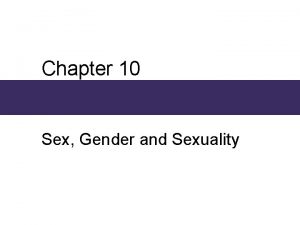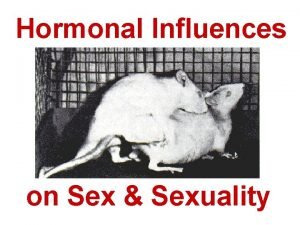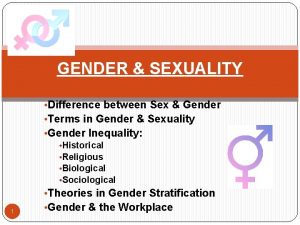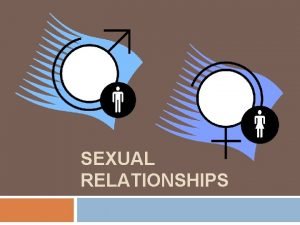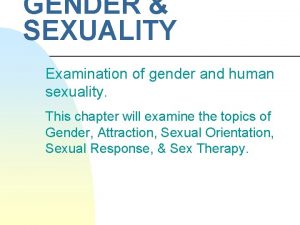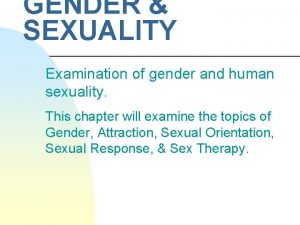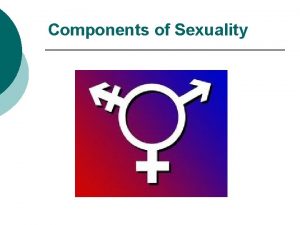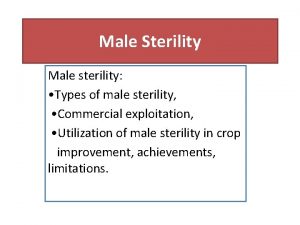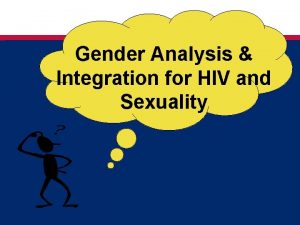Study Area 10 Sexuality and Gender Male and










































- Slides: 42

Study Area 10 Sexuality and Gender

Male and Female Physical Differences • Primary sex characteristics: structures that are present at birth - any of the body structures directly concerned in reproduction • Female primary sex characteristics – vagina: the tube that leads from the outside of a female’s body to the opening of the womb – uterus: the womb in which the baby grows during pregnancy – ovaries: the female sexual glands

Male and Female Physical Differences • Male primary sex characteristics – penis: male sex organ – testes (testicles): the male sex glands – scrotum: external sack that holds the testes – prostate gland: gland that secretes most of the fluid holding the male sex cells or sperm

Male and Female Sexual Organs These figures show the sexual organs of men and women. With the exception of breast tissue development in the female, which occurs during puberty, all of these structures develop during the prenatal period.

Male and Female Physical Differences • Secondary sex characteristics – sexual organs and traits that develop at puberty and are indirectly involved in human reproduction

Male and Female Physical Differences • Female secondary sex characteristics – growth spurt – onset of the menarche cycle: monthly shedding of the blood and tissue that line the uterus in preparation for pregnancy when conception does not occur – breast development § mammary glands: glands within the breast tissue that produce milk when a woman gives birth to an infant

Male and Female Physical Differences • Female secondary sex characteristics – widening hips – pubic hair – fat deposits – further growth and development of the uterus, vagina, and ovaries

Male and Female Physical Differences • Male secondary sex characteristics – enlarged larynx (Adam’s apple) – deepening voice – facial and chest hair – pubic hair – coarser skin texture – large increase in height

Development of Sex Characteristics • Primary sex characteristics develop as the embryo grows – gonads develop at 5 weeks, but embryo could potentially become either male or female – chromosomes determine the release of male or female hormones § estrogens: female sex hormones § androgens: male sex hormones.

Gender • Gender: the psychological aspects of being male or female • Gender roles: the culture’s expectations for masculine or feminine behavior, including: – attitudes – actions – personality traits

Gender • Gender typing: the process of acquiring gender role characteristics • Gender identity: the individual’s sense of being male or female – transgendered: the sense of gender identity does not match their external experience or chromosomes

Biology & Learning Influences on Gender • Biological influences: hormones, chromosomes, and evolutionary selection • Environmental influences: – parenting – culture: individualistic societies with high standards of living are more accepting of nontraditional gender roles, especially for women

Gender Role Development • Social learning theory: gender identity is formed through reinforcement of appropriate gender behavior as well as imitation of gender models

Gender Roles • Gender schema theory: a child develops a mental pattern, or schema, for being male or female and then organizes observed and learned behavior around that schema

Gender Stereotyping • Stereotype: a concept held about a person or group of people that is based on superficial, irrelevant characteristics • Gender stereotype: a concept held about a person or group of people that is based on being male or female

Gender Stereotyping • Sexism: prejudice against males and/or females leading to unequal treatment • Benevolent sexism: acceptance of positive stereotypes of males and females that leads to unequal treatment

Androgyny • Androgyny: characteristic of possessing the most positive personality characteristics of males and females regardless of actual sex – research shows less depression among androgynous people than among traditional men and traditional women

Depression as Influenced by Negative Life Events The bar graph shows that men who are masculine and women who are feminine in their gender roles experience a significant increase in depression when they are exposed to an increased number of life events. The same is not true for people with an androgynous gender role. How might being androgynous allow a person to be more adaptable?

Male & Female Gender Differences • Cognitive differences – male advantage in mathematical and spatial skills – female superiority in verbal skills – decreasing differences • Emotional expression – males tend to talk with each other in a “report” style – females tend to talk to each other in a “relate” style

Stages of Human Sexual Response • Excitement: beginning of sexual arousal • Plateau: physical changes beginning in first stage continue

Stages of Human Sexual Response • Orgasm: a series of rhythmic contractions of the muscles of the vaginal walls or the penis; also the third and shortest phase of sexual response – men: semen released from the penis at orgasm – women: this involves the muscles of the vaginal walls and can happen multiple times, lasting slightly longer than the orgasm experience of the male

Stages of Human Sexual Response • Resolution: the final phase of the sexual response, in which the body is returned to a normal state – refractory period: time period in males just after orgasm in which the male cannot become aroused or achieve erection

The Male Sexual-Response Cycle A male experiences sexual arousal (excitement), a plateau lasting a few seconds to a few minutes, orgasm, and then experiences a refractory period during which another erection is not yet possible. This refractory period can last for several minutes to several hours and tends to increase in length with age. Resolution, in which the body returns to its prearousal state, is last.

The Female Sexual-Response Cycle Women can experience several different patterns of sexual response. In Pattern A, a woman experiences excitement, a plateau, and orgasm in a manner similar to a man. Unlike a man, the woman does not have a refractory period and can experience several orgasms before entering resolution. In Pattern B, there is a longer plateau period but no orgasm, and in Pattern C, the woman goes from excitement to orgasm to a quick resolution without experiencing a plateau period.

Masters and Johnson Study • Masters and Johnson observed and measured physiological responses during all phases of sexual intercourse – used volunteers, some of whom were prostitutes

Kinsey Studies • Series of sexual behavior surveys in the late 1940 s and early 1950 s • Revealed some highly controversial findings about the kinds of sexual behavior common among people in the United States, including: – homosexuality – premarital sex – extramarital sex

Janus Report • Large-scale survey of sexual behavior in the United States in 1990 s • Did not differ widely from Kinsey studies, but looked at many more types of sexual behavior and factors related to sexual behavior, including: – sexual deviance: behavior that is unacceptable according to societal norms and expectations

Sexual Orientation • Sexual orientation: a person’s sexual attraction preference for members of a particular sex – heterosexual: attracted to the opposite sex – homosexual: attracted to the same sex – bisexual: attracted to both men and women

Sexual Orientation An asexual is someone who does not experience sexual attraction. Unlike celibacy, which people choose, asexuality is an intrinsic part of who someone is. There is considerable diversity among the asexual community; each asexual person experiences things like relationships, attraction, and arousal somewhat differently. Asexuality does not make anyone's life any worse or any better, they just face a different set of challenges than most sexual people. Asexuality is distinct from celibacy or sexual abstinence, which are behaviors, while asexuality is generally considered to be a sexual orientation. Some asexuals do participate in sex, for a variety of reasons.

Sexual Orientation • Development of sexual orientation – coming to terms with identities – upbringing and environmental experiences, can be assumed to be a behavior that can be changed – biological differences in the brains of heterosexual and homosexual males – birth order Homosexuality - more common among men who shared their birth mother with older brothers.

Sexual Orientation • Development of sexual orientation – neuroimaging studies § heterosexual men and homosexual women seemed neurologically similar § homosexual men and heterosexual women were neurologically similar – genetic influences on sexual orientation – homosexuals are consistently “feminine” as children – kin selection hypothesis

Sexual Dysfunction • Sexual dysfunction: problem with sexual functioning, or with physical workings of the sex act in one of three areas – sexual interest – arousal – response • Organic or stress-induced dysfunction: sexual problem caused by physical disorder or psychological stress

Sexual Dysfunction • Causes and Influences – organic factors – sociocultural factors – psychological factors

Sexual Dysfunction • Diagnostic and Statistical Manual of Mental Disorders, DSM-5 – sexual desire or arousal disorders – disorders related to the physical act of intercourse – disorders related to the timing or inability to reach orgasm Excerpt: Sexual dysfunctions are a heterogeneous group of disorders that are typically characterized by a clinically significant disturbance in a person’s ability to respond sexually or to experience sexual pleasure. An individual may have several sexual dysfunctions at the same time.

Sexual Dysfunction • Prevalence – worldwide about 40 to 45 percent of women and 20 to 30 percent of men have at least one sexual dysfunction, and the rate increases as we age – for all of the sexual dysfunctions, treatment can include medication, psychotherapy, hormone therapy, stress reduction, sex therapy, and behavioral training

Sexually Transmitted Infections • STIs are also called sexually transmitted diseases, or STDs • Sexually transmitted infections (STI) can affect the sexual organs and the ability to reproduce – may result in pain, disfigurement, and even death • Common bacterial STIs are chlamydia, syphilis, and gonorrhea – treatable with antibiotics

Sexually Transmitted Infections

Sexually Transmitted Infections • Viral STIs include genital herpes (caused by the herpes simplex virus that also causes cold sores) and genital warts (caused by the human papillomavirus) – cannot be cured – can lead to complications, such as increased risk of cancer

Sexually Transmitted Infections • AIDS, (acquired immune deficiency syndrome): sexually transmitted viral disorder that causes deterioration of the immune system and eventually results in death due to complicating infections that the body can no longer fight – caused by human immunodeficiency virus (HIV) – drug treatments are available, but there is no cure


How to Stop the Spread of STIs Using condoms Having only one partner Abstaining from sex Avoiding IV drug use Knowing the symptoms of the various diseases • Getting regular physicals • • •

The END - Chapter 10 Sexuality and Gender
 Chapter 10 sex gender and sexuality
Chapter 10 sex gender and sexuality Androgen insensitivity syndrome
Androgen insensitivity syndrome The difference between sex and gender
The difference between sex and gender Strategic gender needs and practical gender needs
Strategic gender needs and practical gender needs Pretest growth development and sexuality
Pretest growth development and sexuality What is the study of communication, gender and culture
What is the study of communication, gender and culture Sexuality in advertising
Sexuality in advertising What are the 4 strands of sexuality?
What are the 4 strands of sexuality? It is the awareness, acceptance of comfort one's body.
It is the awareness, acceptance of comfort one's body. Definition of sexuality
Definition of sexuality Types of sexual relationships
Types of sexual relationships Which illustrates an emotional aspect of teen sexuality?
Which illustrates an emotional aspect of teen sexuality? Peer sexuality support programme
Peer sexuality support programme Sexuality
Sexuality Sexuality spectrum
Sexuality spectrum Gender inequality case study
Gender inequality case study Transverse perineal muscle
Transverse perineal muscle What is structured programming language
What is structured programming language Cobol area a and area b
Cobol area a and area b Surface area of a cone
Surface area of a cone Cobol area a and area b
Cobol area a and area b Lateral surface area prism
Lateral surface area prism What is the area of the base
What is the area of the base Cleavage of birds
Cleavage of birds Lateral edge
Lateral edge Work study technique
Work study technique Differentiate between time study and motion study
Differentiate between time study and motion study Time and motion study example ppt
Time and motion study example ppt Segmentová inervace těla
Segmentová inervace těla Surfce area
Surfce area Edentulous cast landmarks
Edentulous cast landmarks Ateral surface area
Ateral surface area Filip barinka
Filip barinka Area radicularis
Area radicularis La=ph geometry
La=ph geometry Hexagonal prism volume calculator soup
Hexagonal prism volume calculator soup Masteringmicrobiology study area
Masteringmicrobiology study area Mastering biology.com
Mastering biology.com Study area in project
Study area in project Area of study 2
Area of study 2 San vs nas
San vs nas Area of study change
Area of study change Area of study discovery
Area of study discovery
